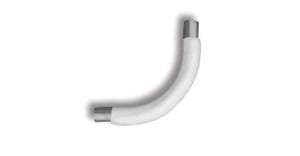July 9, 2007
 At first glance it might appear that pneumatic conveying of dry bulk powders and granules has changed little over the last 25 years. Basic design concepts today are the same as they were in 1980. Systems were and still are categorized as dense or dilute phase, vacuum or pressure.
At first glance it might appear that pneumatic conveying of dry bulk powders and granules has changed little over the last 25 years. Basic design concepts today are the same as they were in 1980. Systems were and still are categorized as dense or dilute phase, vacuum or pressure.
Briefly described, dilute-phase pneumatic conveyors are designed at relatively low pressure differential, relying upon the velocity of the motive gas stream to entrain individual particles at sufficient speed to keep them moving through the pipeline. Dense-phase conveyors are analogous to an extrusion process, relying upon high-pressure differential motive gas to transfer solid slugs of material at low velocity. Dense or dilute systems can utilize either positive or negative pressure differential.
While the basic concepts haven’t changed, evolution within this industry segment has been constant, with new things being introduced regularly. Perhaps the single biggest change has come in the area of new applications for pneumatic systems.
Years ago, dense-phase systems were usually employed to transfer abrasive materials like foundry sand, with dilute phase mainly used to convey nonabrasive products like flour or clay. Today, in addition to being the usual first choice for handling abrasive materials, dense-phase systems are being used to convey all sorts of agglomerated, friable, heavy, or blended bulk solids. Dilute-phase systems are being used today to convey materials that didn’t even exist in the 1980s. Back then, plastic pellets were handled almost exclusively via dilute-phase conveyors, but now they are often transferred at low velocity using high-pressure rotary valves, so as to minimize product degradation and the subsequent generation of fines and streamers.
There was a time when a dense-phase “blow tank or transporter” arrangement consisted of a simple pressure pot and a conveying line, with compressed gas injected at the transporter to provide the motive force. An operator simply filled the vessel with product and then pressurized the tank to push material through the pipeline. Today’s systems are a bit more sophisticated, with the increased use of supplemental conveying-line injectors, also known as air assists or boosters. The motive gas is now added at strategic points along the entire conveying line, not just at the transporter. This development has resulted in systems being designed that intentionally leave material resting in the conveying line after a transfer, thus eliminating the high-velocity surge of air at the end of a cycle. This is commonly referred to as “non-purge” dense-phase conveying. If nonpurge is attempted without the use of line injectors, the system will likely experience line plugging.
Another development in dense-phase conveying technology has been the introduction of the high-density vacuum design. This conveying concept has allowed users to transfer abrasive or friable materials in a low-velocity “dense phase” mode, using negative pressure differential (vacuum pump or positive-displacement blower) as the motive force. A typical application would be the unloading of railcars in areas where traditional pits cannot be used, usually because of a high water table.
Venturi eductors have been used for pneumatic conveying of bulk powders and granular materials for many years. New uses appear regularly. New applications have resulted in numerous design changes, mostly in the area of materials of construction. Eductors are now available in mild or stainless steel, or with ceramic lining. Quick-disconnect sanitary construction is also available. The motive force can be supplied from compressed air, positive displacement, or regenerative blower.
There have been some noteworthy advancements related to pneumatic conveying. These improvements don’t specifically improve the performance of the actual conveying system, but they are closely associated with overall system performance. As an example, the use of programmable logic controllers (PLCs) has greatly increased the reliability and flexibility around the pneumatic system. With a simple modem connection, the system designer can now troubleshoot an installation from a remote location, saving time and money. Tying the PLC to a distributed control system (DCS) has become commonplace, further enhancing the ability to monitor system performance.
Dust collection is an integral part of most pneumatic systems. Many innovations have occurred in this area over the last 25 years. These include the widespread use of cartridge filter media, automated pressure-differential pulse cleaning, and horizontal media arrangements.
The best pneumatic system can be rendered ineffective if product cannot get into or out of the system. Years ago, it was accepted practice to use mechanical vibration as the means to promote product flow. Today, the use of aeration, rather than vibration, as a means of promoting product flow is common. The geometry of product-holding hoppers has radically changed in recent years, with improving material flow the goal. There have also been developments in the area of interior surface coatings, used to enhance product flow. These coatings have good release characteristics and abrasion resistance. Some examples include ultra-high-molecular-weight polyethylene, polyurethane, and plasma and powder coatings.
Rotary feeders have seen several improvements over the years, ranging from enhanced abrasion resistance (such as ni-hard or ceramic), to high-pressure capability. Feeder suppliers’ improved manufacturing processes have resulted in closer tolerances. Sanitary, quick-disassembly designs with exotic surface finishes are now commonplace.
Pipeline components have seen continual improvement, mostly in the areas of increased abrasion resistance, bend configuration, and innovative coupling design. These have been introduced to decrease installation and maintenance costs and increase component life.
Continuous loss-in-weight (L-I-W) gravimetric systems, used to meter products into pneumatic conveyors, were not common 25 years ago. Demand for better process control and accountability has resulted in L-I-W feeders’ being implemented regularly. Design variations of these devices are numerous.
A somewhat disturbing trend seen in pneumatic conveying (and many areas of bulk material handling) relates to the generally competitive nature of business. Twenty-five years ago, most customers purchased equipment with the intention of running it for many years. Today there is a tendency to seek short-term solutions in order to meet budget constraints, which has resulted in equipment being run at higher speeds and pressures, which can unfortunately lead to reduced component life. The old adage, “you get what you pay for” is sometimes being forgotten.
In summary, when it comes to the last 25 years of advancements in pneumatic conveying, the more things change the more they stay the same—or is it the other way around?
Mike Weyandt is the corporate sales manager at Nol-Tec Systems Inc., Minneapolis, MN, a supplier of pneumatic conveying systems and related equipment. He has worked in the bulk material handling industry since 1979, concentrating on pneumatic conveyor design, and can be reached at 651-780-8600, ext. 244 or [email protected]. For more information, go to www.nol-tec.com.
About the Author(s)
You May Also Like




